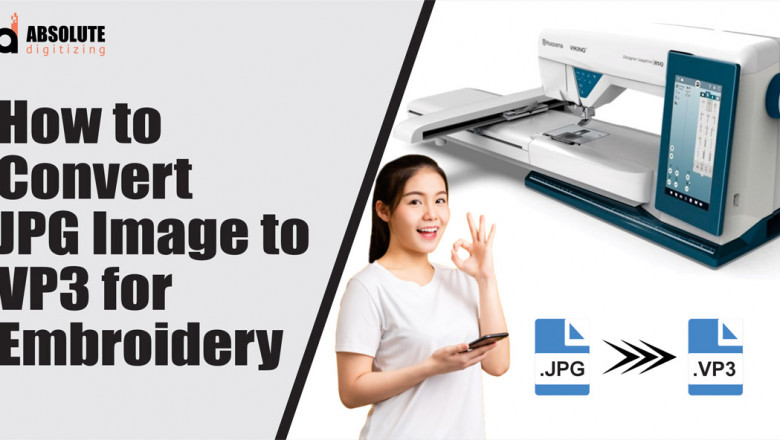views
In the world of embroidery, having your logo in the right format is everything. Whether you're a small business, a brand, or just someone who wants their design stitched onto fabric, using the right embroidery file format can save you a ton of time and effort. One of the most common and user-friendly formats in the embroidery world is VP3.
If you’ve been wondering how to convert your logo to VP3 format for embroidery, you’re in the right place. In this guide, we’ll walk you through the basics of VP3 files, why they matter, and how to get your logo converted quickly and correctly—without the tech headaches.
What is a VP3 File?
A VP3 file is a machine embroidery format primarily used by Husqvarna Viking and Pfaff embroidery machines. It contains detailed instructions that tell the embroidery machine how to stitch your design including thread colors, stitch type, sequence, and more.
VP3 files are compact, efficient, and widely compatible with home embroidery machines. That’s why they’re a popular choice for small business owners, hobbyists, and embroidery enthusiasts alike
Why Convert Your Logo to VP3 Format?
So, what’s the big deal with VP3? Why not just upload your JPG or PNG logo and press "go" on the embroidery machine?
Here’s the truth: Embroidery machines can’t read regular image files like JPG, PNG, or SVG. They need a digitized embroidery file in this case, a VP3 that tells the machine where, how, and when to place every single stitch.
Here’s why converting your logo to VP3 is essential:
-
Machine-Ready: Your design is ready to load and embroider without extra work.
-
Accurate Stitching: The digitized file ensures precision in every thread.
-
Preserves Design Integrity: Your logo won’t come out distorted or unrecognizable.
-
Custom Fit: The file is tailored to the fabric and size you need.
How to Convert Your Logo to VP3 Format
Whether you’re a DIYer or prefer to leave it to the pros, converting a logo to VP3 format follows a few simple steps.
Step 1: Prepare Your Logo
Start with a high-resolution file. Ideally, your logo should be in:
-
Vector format (AI, EPS, or SVG) for best results
-
PNG or JPG if vector is unavailable (but keep it clean and high-res)
Avoid using low-quality images or screenshots, as they make the digitizing process more difficult and less accurate.
Step 2: Digitize the Logo
This is the magic step—turning your image into stitch data.
You have two options here:
DIY Digitizing (Advanced Users)
If you’re experienced with embroidery software like Embird, Hatch, or SewArt, you can manually digitize your logo and export it as a VP3 file. This method gives you control over stitch types, density, and direction.
But keep in mind: digitizing requires both software and skill. One wrong move can result in a bad stitch-out.
Hire a Professional Digitizer
If you want your logo converted quickly and accurately, professional services are the way to go. We recommend Absolute Digitizing they specialize in custom embroidery digitizing and offer affordable rates starting at just $10 per logo.
You send them your logo, tell them your size and fabric, and they return a ready-to-use VP3 file simple!
Step 3: Load the VP3 File into Your Machine
Once your VP3 file is ready:
-
Transfer it via USB, SD card, or direct connection to your embroidery machine.
-
Preview the design on the machine’s screen.
-
Choose your thread colors and start stitching!
That’s it you’re on your way to professional-quality embroidery.
What Can You Embroider with a VP3 Logo?
Once your logo is in VP3 format, the possibilities are endless. You can embroider on:
-
Polos and t-shirts
-
Jackets and uniforms
-
Caps and hats
-
Tote bags and backpacks
-
Towels and home décor
-
Patches and emblems
Whether you're branding your business or crafting custom gifts, VP3 makes embroidery smooth and professional.
Tips for the Best Results
Want to make sure your logo stitches out perfectly? Here are some pro tips:
Know the Size
Let your digitizer know the exact size the logo will be embroidered. Stitch density and detail vary based on dimensions.
Choose the Right Fabric
Thicker materials like denim or fleece require different stitch settings than cotton or silk. Always mention the fabric type.
Avoid Tiny Text
Small fonts don’t always embroider well. Stick to bold, simple text for clarity.
Review the Proof
Before stitching the final product, ask your digitizer for a preview or stitch simulation. It helps catch potential issues early.
Why Work with Absolute Digitizing?
There are many digitizing services out there, but Digitizing Buddy stands out for several reasons:
-
100% Manual Digitizing: No shortcuts or auto-digitizing tools
-
Quick Turnaround: Most designs ready within 24 hours
-
Affordable Pricing: Starting at $10 per design
-
Free Revisions: Ensures your satisfaction
-
Multiple Formats: Including VP3, DST, PES, EXP, JEF, and more
Whether you're a small business owner, designer, or hobbyist, they make embroidery digitizing fast, affordable, and hassle-free.
Frequently Asked Questions
Can I convert a JPG to VP3 by myself?
Yes, but only if you have embroidery digitizing software. You can’t simply “save as VP3” like you would with image formats.
Do all embroidery machines accept VP3?
No, only certain machines like Pfaff and Husqvarna Viking read VP3 files. Other machines use DST, PES, EXP, or JEF.
What if I need the logo in multiple formats?
No problem! Most professional digitizers will export your design in multiple formats upon request.
Final Thoughts: Go from Logo to Thread with VP3
If you want your logo to look crisp, clean, and professional on embroidered items, converting it to the VP3 format is a must especially if you use Husqvarna or Pfaff machines.
Instead of struggling with complicated software or risking bad results, trust a reliable digitizing service like Digitizing Buddy to get it done right the first time.














Comments
0 comment